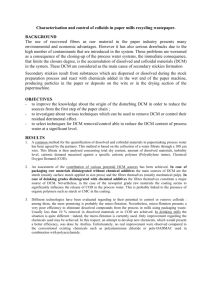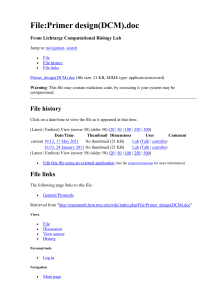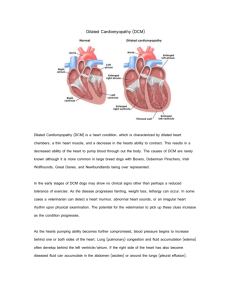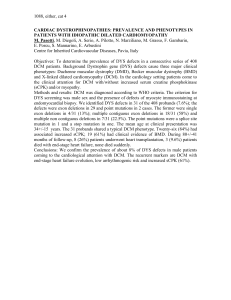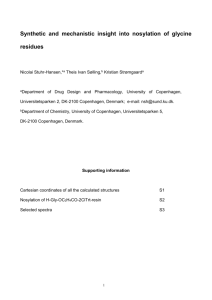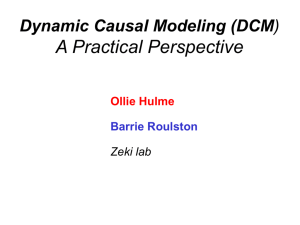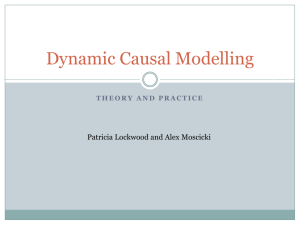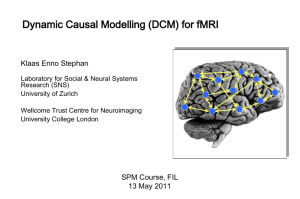LINKING TOGETHER SUPPLY AND DEMAND CHAINS
advertisement
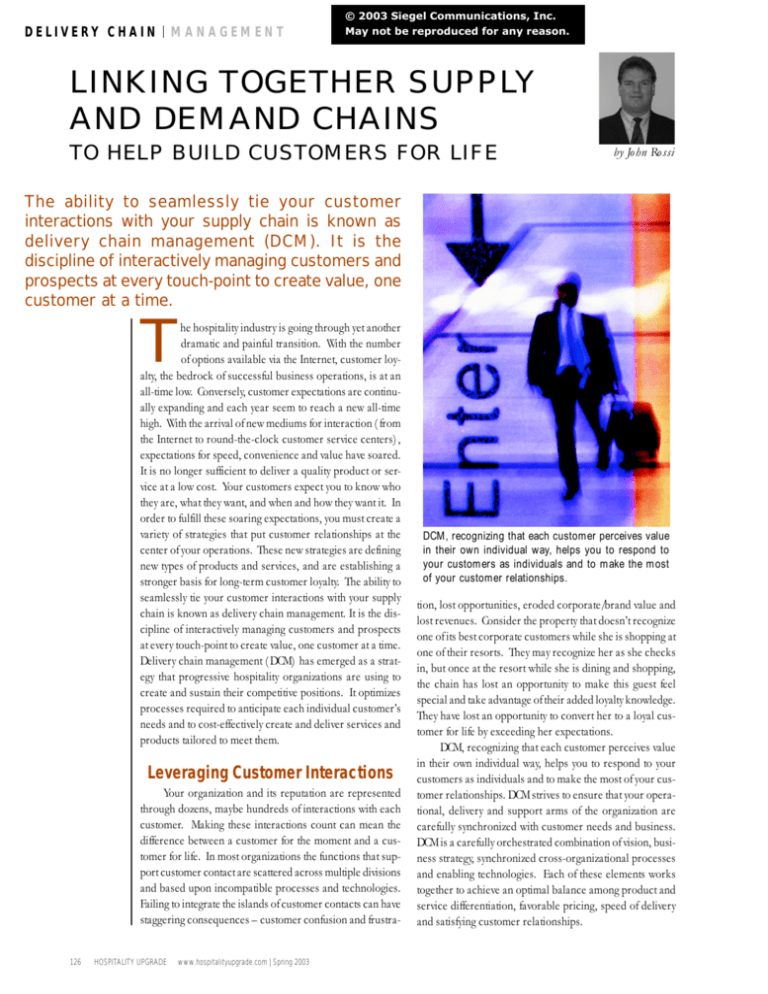
DELIVERY CHAIN MANAGEMENT © 2003 Siegel Communications, Inc. May not be reproduced for any reason. LINKING TOGETHER SUPPLY AND DEMAND CHAINS TO HELP BUILD CUSTOMERS FOR LIFE by John Rossi The ability to seamlessly tie your customer interactions with your supply chain is known as delivery chain management (DCM). It is the discipline of interactively managing customers and prospects at every touch-point to create value, one customer at a time. T he hospitality industry is going through yet another dramatic and painful transition. With the number of options available via the Internet, customer loyalty, the bedrock of successful business operations, is at an all-time low. Conversely, customer expectations are continually expanding and each year seem to reach a new all-time high. With the arrival of new mediums for interaction (from the Internet to round-the-clock customer service centers), expectations for speed, convenience and value have soared. It is no longer sufficient to deliver a quality product or service at a low cost. Your customers expect you to know who they are, what they want, and when and how they want it. In order to fulfill these soaring expectations, you must create a variety of strategies that put customer relationships at the center of your operations. These new strategies are defining new types of products and services, and are establishing a stronger basis for long-term customer loyalty. The ability to seamlessly tie your customer interactions with your supply chain is known as delivery chain management. It is the discipline of interactively managing customers and prospects at every touch-point to create value, one customer at a time. Delivery chain management (DCM) has emerged as a strategy that progressive hospitality organizations are using to create and sustain their competitive positions. It optimizes processes required to anticipate each individual customer’s needs and to cost-effectively create and deliver services and products tailored to meet them. Leveraging Customer Interactions Your organization and its reputation are represented through dozens, maybe hundreds of interactions with each customer. Making these interactions count can mean the difference between a customer for the moment and a customer for life. In most organizations the functions that support customer contact are scattered across multiple divisions and based upon incompatible processes and technologies. Failing to integrate the islands of customer contacts can have staggering consequences – customer confusion and frustra- 126 • HOSPITALITY UPGRADE • www.hospitalityupgrade.com | Spring 2003 DCM, recognizing that each customer perceives value in their own individual way, helps you to respond to your customers as individuals and to make the most of your customer relationships. tion, lost opportunities, eroded corporate/brand value and lost revenues. Consider the property that doesn’t recognize one of its best corporate customers while she is shopping at one of their resorts. They may recognize her as she checks in, but once at the resort while she is dining and shopping, the chain has lost an opportunity to make this guest feel special and take advantage of their added loyalty knowledge. They have lost an opportunity to convert her to a loyal customer for life by exceeding her expectations. DCM, recognizing that each customer perceives value in their own individual way, helps you to respond to your customers as individuals and to make the most of your customer relationships. DCM strives to ensure that your operational, delivery and support arms of the organization are carefully synchronized with customer needs and business. DCM is a carefully orchestrated combination of vision, business strategy, synchronized cross-organizational processes and enabling technologies. Each of these elements works together to achieve an optimal balance among product and service differentiation, favorable pricing, speed of delivery and satisfying customer relationships. DELIVERY CHAIN © 2003 Siegel Communications, Inc. May not be reproduced for any reason. MANAGEMENT FIGURE 1. The diagram shows how delivery chain management combines the best practices of supply chain management and demand chain management to make organizations more efficient and market wise. By utilizing practices from both demand chain management and supply chain management, organizations can maintain an optimal flow of people, resources and information to drive quality into service delivery activities. The Advent of the Value Chain Value chains link together and sequence through an organization resulting in a product or service being delivered to a customer. Since the value chain spans all of the direct support activities within an organization and focuses on an organization’s value to its customers, it provides a broad foundation for managing the delivery of products and services. Value chain analysis can be used to clarify what DCM is and is not, and how it differs from other business strategies. For example, value chain analysis categorizes enterprise activities into several major categories. These groupings are: inbound logistics, operations, outbound logistics, marketing and sales and service. One of today’s most prominent business strategies, supply chain management, supports activities associated with inbound logistics and operations. More specifically, supply chain management is concerned with the optimal ordering, receipt and handling of materials and supplies. On the surface it looks like it has little effect on customer relationships. In fact, organizations that focus on optimizing the supply chain run the risk of missing opportunities in optimizing customer relationships and needs fulfillment. Delivery chain management extends supply chain management through its direct interaction with the customer. Figure 1 shows how delivery chain management combines the best practices of supply chain management and demand chain management to make organizations more efficient and market-wise. By utilizing practices from both demand chain management and supply chain management, organizations can maintain an optimal flow of people, resources and information to drive quality into service delivery activities. DCM Supports Far More Than Customer Interactions Delivery chain management spans the back-of-house operations, distribution centers, marketing and sales departments and service components of the enterprise. It seeks to create cross-organizational links that integrate the customer contact functions with other parts of the organization. As a result, the enterprise is able to marshal the appropriate resources to ensure a consistent and effective response to each customer contact. This one-on-one relationship allows the organization to uncover new opportunities for enhancing customer value and revenue generation. It’s the ability to 128 • HOSPITALITY UPGRADE • www.hospitalityupgrade.com | Spring 2003 convert a browser into a buyer. When a gift shop is out of an item, the customer service representative should offer that browser the option of having it delivered to their room within a few hours, or delivered to their home for an addition $5.95 in shipping. Incremental revenue is available if you link your existing applications, information and business processes together. A closer look at the service component of the enterprise-wide value chain illustrates this point. There are potentially many value processes associated with the service component. This may include such processes as post-visit customer relationships, the scheduling and dispatching of purchased products, service at the point-of-purchase, reservations and loyalty-based management. Each of these processes encompasses numerous activities. With DCM, it is important that the enabling technologies and processes be integrated throughout the value chain. There are numerous customer-specific strategies, most of which focus on only one aspect of customer interaction and offer a specific packaged solution, such as property management, point-of-sale or sales and catering. Compared to these strategies, DCM provides a broader scope of support and contextual framework under which all services are integrated. This will reach further back into an organization’s value chain and deeper into the organization’s structure. The broader scope of coverage means that more organizational activities are coordinated and enhanced through integrated systems and shared information. Today’s organizations have a wide variety of technologies to choose from to assist them in achieving their strategic objectives. However, in cases where organizations wish to place their customers at the center of business strategy, several technologies rise above the rest to play a prominent role. The technologies most closely associated with delivery chain management are: • • • • Customer contact centers E-business Workflow and document management Information warehousing You must look at these technologies being horizontally aligned throughout your organization. Many hospitality organizations have created silos of information and have not transversed the data from their existing software packages. Loyalty programs must be used to review a customer’s complete value to your organization, not just DELIVERY CHAIN their number of room nights or food and beverage spending. You must begin to know your customer’s preferences in every situation. You need to understand that they like to swim in the morning, eat breakfast while reading the USA Today and that their flight is scheduled to leave at 4:00 p.m. All of this information is available if you can give your guests a reason to pass it on to you. You must then consider all of their activity through various touch points in your entire delivery chain. All customers’ value perspectives are different. Some only consider the price of the room. Some view the entire experience as a disparate set of services and may value some more than others (e.g. having a pool or exercise center). Competitive bidding for room rates on the Web has decreased margins and coerced the commodity image of the hospitality industry. Regaining customer loyalty can only be achieved through differentiating your total value proposition from your competitors and executing on that strategy (i.e. delivering to the customer). This can only be achieved by tying your traditional supply chain activities with your customer-facing demand chain activities. This process change within your organization will be enabled by tighter technology and data integration. stronger customer relationship building can be enhanced without making expensive technology investments. While considering these types of changes, you should determine: • Information or services that leverage customer relationships to their fullest advantage • Opportunities for proactive fulfillment (hint: identify customersensitive trigger points and provide information/services that make life easier) • How you can use information that you already have about your customers to anticipate their needs MANAGEMENT Enhanced customer satisfaction, incremental revenue and building stronger loyalty may be attained by horizontally integrating many of your existing technologies. Although there are additional enabling technologies that will create some shortcuts, with most 2003 IT budgets being flat, implementing portions of delivery chain management may be the best strategy. John Rossi is a vice president with the W. Capra Consulting Group and has worked in the hospitality industry for the last 20 years. He may be reached at jrossi@wcapra.com or (312) 873-3269. DCM Is Easier Than You Think There is a lot an organization can do to implement aspects of DCM without making investments in new technology. For example, management can define a DCM vision, develop customer-focused strategies and improve business processes. Here are several guidelines for taking these steps. To begin, you must look at the organization’s processes. A DCM strategic vision is a great starting point. This guiding principle will state how the organization intends to outperform its competition in providing products and services to its customers. This vision contains specific strategies for leveraging customer encounters and will lead to a framework to integrate your back office systems with your customer-facing systems. You probably own the technologies necessary to better understand your customers. Making these process improvements is a critical step in the direction of effective delivery chain management. Many processes that support better customer contacts and HOSPITALITY UPGRADE • www.hospitalityupgrade.com | Spring 2003 • 129



